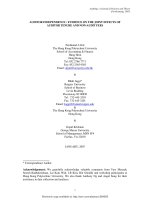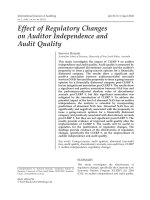bergner - 2011 - auditor rotation and auditor independence - an investigation using social identity theory and accountability
Bạn đang xem bản rút gọn của tài liệu. Xem và tải ngay bản đầy đủ của tài liệu tại đây (7.36 MB, 197 trang )
DISSERTATION
Jason Marlin Bergner
The Graduate School
University of Kentucky
2011 AUDITOR ROTATION AND AUDITOR INDEPENDENCE:
AN INVESTIGATION USING SOCIAL IDENTITY THEORY AND
ACCOUNTABILITY
DISSERTATION
A dissertation submitted in partial fulfillment of
requirements for the degree of Doctor of Philosophy in the
College of Business and Economics
at the University of Kentucky
By
Jason Marlin Bergner
Lexington,
Kentucky
Director: Dr. Robert Ramsay, Professor of Accounting
Lexington,
Kentucky
2011
Copyright © Jason Marlin Bergner 2011
UMI Number: 3501618
All rights reserved
INFORMATION TO ALL USERS
The quality of this reproduction is dependent upon the quality of the copy submitted.
In the unlikely event that the author did not send a complete manuscript
and there are missing pages, these will be noted. Also, if material had to be removed,
a note will indicate the deletion.
UMI
Dissertation Publishing
UMI 3501618
Copyright 2012 by ProQuest LLC.
All rights reserved. This edition of the work is protected against
unauthorized copying under Title 17, United States Code.
uest
ProQuest LLC
789 East Eisenhower Parkway
P.O. Box 1346
Ann Arbor, Ml 48106-1346
ABSTRACT OF DISSERTATION
AUDITOR ROTATION AND AUDITOR INDEPENDENCE:
AN INVESTIGATION USING SOCIAL IDENTITY THEORY AND
ACCOUNTABILITY
The AICPA and GAO claim that audit partner rotation provides
substantially the same benefits (independence) as audit firm rotation.
Meanwhile, the PCAOB has solicited comments on a potential regulation
requiring the lead engagement partner's personal signature to appear on the
publicly disclosed audit report. In this experiment-based dissertation, I use
Social Identity Theory to make predictions regarding auditors' independence
levels in partner and firm rotation scenarios. I also investigate accountability's
effect on auditors' decisions, including how accountability interacts with
identification. The results suggest identification interacts with accountability in
affecting auditors' decision making and that auditors may make different
decisions under partner and firm rotation. These results are informative to the
PCAOB and practitioners in discussing the current issues of firm rotation and
partner signing.
KEYWORDS: audit partner rotation, auditor independence, mandatory rotation,
accountability, Social Identity Theory
Student's signature
Date
ABSTRACT OF DISSERTATION
Jason Marlin Bergner
The Graduate School
University of Kentucky
2011
AUDITOR ROTATION AND AUDITOR INDEPENDENCE:
AN INVESTIGATION USING SOCIAL IDENTITY THEORY AND
ACCOUNTABILITY
ABSTRACT OF DISSERTATION
A dissertation submitted in partial fulfillment of
requirements for the degree of Doctor of Philosophy in the
College of Business and Economics
at the University of Kentucky
By
Jason Marlin Bergner
Lexington,
Kentucky
Director: Dr. Robert Ramsay, Professor of Accounting
Lexington,
Kentucky
2011
Copyright © Jason Marlin Bergner 2011
ABSTRACT OF DISSERTATION
AUDITOR ROTATION AND AUDITOR INDEPENDENCE:
AN INVESTIGATION USING SOCIAL IDENTITY THEORY AND
ACCOUNTABILITY
The AICPA and GAO claim that audit partner rotation provides
substantially the same benefits (independence) as audit firm rotation.
Meanwhile, the PCAOB has solicited comments on a potential regulation
requiring the lead engagement partner's personal signature to appear on the
publicly disclosed audit report. In this experiment-based dissertation, I use
Social Identity Theory to make predictions regarding auditors' independence
levels in partner and firm rotation scenarios. I also investigate accountability's
effect on auditors' decisions, including how accountability interacts with
identification. The results suggest identification interacts with accountability in
affecting auditors' decision making and that auditors may make different
decisions under partner and firm rotation. These results are informative to the
PCAOB and practitioners in discussing the current issues of firm rotation and
partner signing.
KEYWORDS: audit partner rotation, auditor independence, mandatory rotation,
accountability, Social Identity Theory
S|ude,nt's signatu
Date
AUDITOR ROTATION AND AUDITOR INDEPENDENCE:
AN INVESTIGATION USING SOCIAL IDENTITY THEORY AND
ACCOUNTABILITY
By
Jason Marlin Bergner
Director bT-Gc&duate Studies
Date
ACKNOWLEDGEMENTS
I wish to express sincere gratitude to the University of the Kentucky, the
UK Graduate School, the Gatton College of Business and Economics, and the
Von Allmen School of Accountancy for their continued financial support.
The following dissertation, while an individual work, has benefited greatly
from the insights and direction of several people. First, my Dissertation Chair,
Dr. Robert Ramsay, exemplifies the high quality scholarship to which I aspire.
Our meetings and his comments proved invaluable during this process. I also
wish to thank the rest of the Dissertation Committee for their helpfulness,
critiques, and time in helping me to achieve this
goal:
Dr. Jeff Payne, Dr. Sean
Peffer, and Dr. Richard Smith.
I also wish to thank those outside the Committee whose comments and
constructive criticisms were especially helpful: Hank Alewine, Bill Messier, Tim
Miller, Dan Stone, and Steve Sutton. I apologize to anyone whom I have
inadvertently left off this list. All remaining errors within are mine alone.
Finally, I wish to thank my family, my wife Jody and our children. Their
support and encouragement brightened the darkest periods of this entire
educational process and gave me the incentive to work as hard as I could each
day.
iii
TABLE OF CONTENTS
Acknowledgements iii
List of Tables vi
List of Figures vii
Chapter
1:
Introduction 1
Objective 1
Motivation 3
Contribution 7
Organization 8
Chapter 2: Literature review 9
Organization 9
Auditor independence 10
Constraints inhibiting auditor independence 11
Incentives encouraging auditor independence 13
Auditor rotation and independence 15
Audit firm and partner rotation 16
Introduction 16
Audit firm rotation 17
Archival partner rotation 26
Audit firm v. audit partner rotation 28
Summary 30
Social Identity Theory 32
General 32
Organizational commitment 34
Organizational identification 35
Client identification 36
Professional identification 38
Accountability 40
Accountability and identification 42
Chapter 3: Hypotheses development and research design 45
Chapter overview 45
Hypotheses development 45
Experimental design 54
Participants 54
Instrument handling 55
Design 57
Dependent variables 58
Independent variables *. 61
Other variables 63
Materials and procedures 64
iv
Chapter
4:
Results 69
Chapter overview 69
Pilot sample of undergraduate auditing students 69
Descriptive statistics 69
Manipulation checks 70
Hypothesis testing 71
Additional analysis 79
Discussion 81
Professional auditor sample 83
Descriptive statistics 83
Manipulation checks 85
Hypothesis testi ng 84
Additional analyses 92
Chapter 5: Discussion and conclusion 99
Chapter overview 99
Summary of findings 99
Limitations 101
Future research 101
Appendix A - Online version of instrument 103
Appendix B- Paper and pencil version of instrument 145
References 176
VITA 184
v
LIST OF TABLES
Table 2.1 - Countries undercurrent Mandatory Firm Rotation 21
Table 4.1 - Manipulation Check Results for Pilot Study 70
Table 4.2 - Results of Confirmatory Factor Analysis 72
Table 4.3 - Effect of Rotation Type and Accountability on Auditors' Client
Id entifi cation 74
Table 4.4 - Effect of Client Identification and Accountability on Auditors'
Independence 76
Table 4.5 - Effect of Rotation Type and Accountability on Auditors'
Independence 77
Table 4.6 - Effect of Client ID and Accountability on Auditors' Independence,
Gender Covariate Included 81
Table 4.7 - Demographic Information for Auditor Sample 84
Table 4.8 - Manipulation Check Results for Auditor Study 85
Table 4.9 - Results of Confirmatory Factor Analysis 86
Table 4.10 - Effect of Rotation Type and Accountability on Auditors' Client
Identification 89
Table 4.11 - Effect of Client Identification and Accountability on Auditors'
Independence 91
Table 4.12 - Effect of Rotation Type and Accountability on Auditors'
Independence 92
Table 4.13 - Effect of Rotation Type and Accountability on Auditors' Client
Identification, partner and senior manager subsample 94
Table 4.14 - Effect of Client Identification and Accountability on Auditors'
Independence, partner and senior manager subsample 96
VI
LIST OF FIGURES
Figure 3.1 - Dissertation Model 51
Figure
4.1
- Effects of Client Identification and Accountability on Warranty
Adjustment 79
Figure 4.2 - Effect of Rotation Type and Accountability on Auditors' Client
Identification, partner and senior manager subsample 95
Figure 4.3 - Effects of Rotation Type and Accountability on Likelihood of
Requiring Client to Restate Prior Year's Earnings, partner and senior
manager subsample 97
vii
Chapter
1:
Introduction
Objective
This dissertation investigates auditor independence under two different
scenarios: partner rotation and firm rotation
1
. The General Accounting Office
(2003) and the American Institute of Certified Public Accountants (1992) both
claim that the current U.S. requirement of mandatory partner rotation has
substantially the same benefits (read: independence) as mandatory firm rotation,
rendering mandatory firm rotation unnecessary. I investigate this claim and
investigate if auditors are equally independent under partner and firm rotation
scenarios.
I also investigate how accountability may a) mitigate the potential
differences in auditors' independence levels and b) interact with auditors' client
identification. Although many facets of accountability exist in the current audit
environment (concurring partner review, Audit Committee, etc.), I examine
accountability using an issue currently under discussion by the Public Company
Accounting Oversight Board (PCAOB); namely, the proposed requirement for the
lead audit partner to sign his/her name to the publicly disclosed audit report.
2
I develop a model of auditor rotation and test this model using an
experiment to explore audit partners' independence based upon the type of
"new" client (rotating in from another partner within the firm versus rotating in
1
In an auditing context, "rotation" refers to the idea of limiting the number of consecutive years an
auditor can audit a client. In "partner rotation," the lead engagement partner must pass that
responsibility to another partner in the firm after a fixed number of years. In "firm rotation," the
audit firm itself must withdraw from the engagement (thus forcing the client to seek a new audit
firm) after a fixed number of years.
2
1 use the terms "lead audit partner" and "lead engagement partner" interchangeably.
2
from a different firm) coming under the partner's purview and the potential effect
of signing one's name to the publicly disclosed audit report on partners'
independence levels. In the first part of the model, I test whether auditors under
a firm rotation scenario will identify (Social Identity Theory) with their clients
differently than those under partner rotation. In other
words,
I test whether
rotation type is an antecedent of identification. Bamber and Iyer (2007) find that
three constructs are antecedents of identification: auditors' individual tenure with
the client, client "importance," and client "image." Antecedents to identification
are important because research shows that auditors make different decisions
based upon their identification levels with clients (Bamber and Iyer 2007). Thus,
if rotation type is an antecedent to identification, it should follow that auditors'
decision making will be different under firm v. partner rotation.
In the second part of the model, I investigate how auditors' identification
levels with the client and accountability affects their decision making. As
mentioned earlier, previous research (Bamber and Iyer 2007) shows that
auditors' identification levels affect their decision making. However, no research
has studied whether a) accountability measures will mitigate any differences in
identification and b) whether accountability and identification interact. Though
the interaction between accountability and identification has not been studied in
the auditing literature, it has been shown in the psychology literature (Baretto and
Ellemers 2000, Smith et al. 2007). In some psychological studies, accountability
has been shown to interact with identification by affecting those who are
"high"
identifiers (Reicher and Levine 1994). In other studies, it is the "low" identifiers
3
who are affected by accountability (Baretto and Ellemers 2000). Therefore, a
priori,
it is unclear how auditors' identification with clients may be affected by
accountability.
In this dissertation, I assume that auditors' independence levels are
revealed by their decision making. Therefore, I am able to measure auditors'
independence levels directly. Unlike many archival studies that indirectly
measure auditor independence with proxies such as earnings quality, I directly
measure auditor independence, using auditors' decisions about requiring the
posting of an adjusting entry, the amount to insist on being posted as an
adjusting entry, whether to give a going concern opinion, and whether to insist on
a restatement of the previous year's financial statements.
This experimentally-based dissertation seeks to provide direct evidence
on auditors' independence levels in partner versus firm rotation settings as well
as the effect of requiring lead audit partners to sign the audit report. Standard
setters have looked at these issues in the past
(e.g.,
GAO 2003) and continue to
do so today (PCAOB 2009). I strive to provide a priori evidence on the potential
consequences of implementing these standards.
Motivation
Previous researchers, both archival and experimental, have tested the
potential effects of requiring mandatory firm rotation. However, these studies
have examined firm rotation versus no rotation (Dopuch et al. 2001) or have
investigated how audit firm tenure is related to audit quality, often using earnings
4
quality proxies as proxies for audit quality
(e.g.,
Myers et al. 2003). In the former
case,
effects of firm rotation versus non rotation can be directly measured, but
the omission of the partner rotation variable makes these studies unable to
answer the claim of equality of benefits in partner and firm rotation settings. In
the latter case, firm rotation is not manipulated. Associations between short
and/or long tenure and earnings quality (for instance) are examined to see if firm
rotation is warranted. Neither do these studies address the question of firm
versus partner rotation.
A few archival-based studies have investigated firm and partner tenure
settings, made possible by the fact that some countries require the lead audit
partner to sign the publicly disclosed audit report
(e.g.,
Taiwan). Research here
has yielded mixed results, with some supporting firm rotation (Chi and Huang
2005) and some against (Knechel et al. 2007). However, these studies cite the
limitation of these results generalizing to cultures and markets outside of their
specific locales, as well as the limitations of using proxies to measure audit
quality. Chi et
al.
(2009) state their inferences "critically depend" on the ability of
accrual-based proxies to capture audit quality, proxies that are called into
question by Bamber and Bamber (2009).
3
Additionally, earnings opacity
(Bhattacharaya et al. 2003), accounting and auditing practice in corporate
3
Bamber and Bamber (2009) question common proxies used to capture audit quality, such as
abnormal accruals. Proxies like abnormal accruals are commonly used to measure earnings
quality in the financial accounting literature. The logic then proceeds that companies with higher
earnings quality also have high-quality audits. However, this does not necessarily
hold.
A
company with high quality earnings via strong internal controls and thorough, honest
management would publish financial statements with high quality earnings regardless of whether
the auditor was thorough. On the other hand, the financials could be of such low quality that even
the best auditor may not be able to catch everything and thus yield financials with lower earnings
quality.
5
governance (Francis et al. 2003), and audit markets (Choi and Wong 2004) are
different around the world, making generalizations from one market to another
difficult.
Some countries have idiosyncrasies in their firm rotation policies rendering
the results of studies done using this data problematic. For example, Kim et al.
(2004) find support for mandatory firm rotation in Korea, but the Korean
government "appoints" the new external auditor for the firm when rotation is
deemed to be "warranted." This "appointment" of an external auditor by the
government would yield results that may not apply to a potential mandatory firm
rotation policy in the United States, where the "new" auditor (following firm
rotation) may be decided by a competitive bidding process instead of government
appointment.
Two competing theories offer predictions regarding audit partners'
decision-making for a new client from outside the
firm.
Economic theory
suggests audit firms "low-ball" (DeAngelo 1981) new clients in order to gain their
business.
4
Partners have an economic incentive to maintain their clients long
enough to recoup the initially foregone profits, and therefore are more likely to
acquiesce to a client's position regarding the audit findings. This theory suggests
that auditors have an economic incentive to be less independent for new clients
under firm rotation than partner rotation. However, in a firm rotation scenario, an
4
"Low-balling" refers to the idea that audit firms reduce fees in order to gain the client's business,
even if it means taking a loss on the client in the initial years of the engagement. As the
relationship continues, the auditor becomes more efficient in auditing the client, reducing costs
and possibly raising the fee, with the result being that the auditor is now turning a profit on the
client and is able to recover the foregone profit from the initial years.
6
audit firm would have less time to recoup foregone profits, which may in turn
mitigate the low-balling effect.
On the other hand, Social Identity Theory predicts that auditors should be
more willing to acquiesce to partner-rotated clients due to their identification with
the client (Ashforth and Mael 1989). This is because a firm-rotated client is seen
as a member of the "outgroup," as the partner has less history and familiarity with
the firm compared to partner-rotated firms. Thus, Social Identity Theory would
predict auditors would be less independent under partner rotation than firm
rotation.
Additionally, I study a potential effect of requiring auditors in the U.S. to
sign their names to the publicly disclosed audit report. This potential requirement
is currently being discussed by the PCAOB (2009). The thinking behind this idea
is that requiring the partner to sign the publicly disclosed audit report will increase
partners' perceptions of their accountability, which will result in increased
independence. Although accountability measures known a priori by participants
have resulted in greater conservatism (DeZoort et al. 2006), it is unknown if the
signing requirement will influence auditor behavior, as audit partners are already
required to sign their names to the audit report.
5
The proposed standard would
change the partner's signature to one that is publicly
disclosed.
More
importantly, will the signing requirement mitigate any differences in
independence levels? If so, implementing the signing requirement of the publicly
5
In current practice, the lead engagement partner signs his/her name giving permission for the
audit report to be released to the public. However, the signature does not appear on the public
copy of the audit report itself. Thus, financial statement users cannot identify the lead
engagement partner from the audit report. The proposed standard would require the lead
engagement partner's signature to appear on the publicly disclosed audit report.
7
disclosed audit report could be a way to ensure higher quality audits under
partner rotation without requiring firm rotation.
Contribution
This dissertation contributes to the academic field by presenting evidence
on the comparison between auditors' independence for a client rotated in from
another partner versus one rotated in from an outside
firm.
There has been
scant research into this area, and almost none at the experimental level.
Providing evidence about governing bodies' claims that partner and firm rotation
provide substantially the same benefits will help assist in the development of
research targeting the specific benefits and costs of partner versus firm rotation
called for recently in the literature (Bamber and Bamber 2009, DeFond and
Francis 2005).
Auditors strive to maintain objectivity and independence in their decision
making (AICPA, 2010). Research uncovering situations in which they may not
be completely objective will aid their pursuit of conducting high quality audits.
Furthermore, the investigation into potential effects of requiring auditors to sign
the publicly disclosed audit report contributes to practice, as it provides evidence
on whether having partners sign their names will result in increased
independence. This has practical implications for two key issues being
discussed by governing bodies: 1) mandatory firm rotation and 2) requiring the
lead engagement partner to sign the audit report. I seek to shed light on both
issues by providing a priori evidence of the potential effects of implementing
8
these requirements in practice and potentially inform both the PCAOB and the
auditing practice as a whole when discussing potential implantation of new
standards.
Organization
The remainder of this dissertation proceeds in the following manner:
Chapter 2 presents the literature review for this topic. Chapter 3 develops the
hypotheses and offers the methodology used in conducting this study. Chapter 4
reports the results of the study. Chapter 5 concludes with a summary discussion
of the dissertation, including limitations of the study and avenues for potential
research.
Copyright © Jason Marlin Bergner 2011
9
Chapter
Two:
Literature Review
Organization
This chapter begins with an discussion of conflicts-of-interest encountered
by auditors. How do these potentially inhibit independence? What incentives
seek to promote independence and counter the effects of these conflicts-of-
interest? This discussion is beneficial to understanding how my research
question(s) fits into the broader topic of auditor independence.
Next, the chapter looks at relevant research related to audit firm and
partner rotation. Most published papers have approached the question of firm
rotation by examining audit tenure from an archival-based method using U.S.
data.
This approach, however, has not addressed partner rotation. Social
Identity Theory is discussed next, focusing on organizational, professional and
client identification, and identification in audit research. The chapter concludes
with a section on accountability and how accountability interacts with
identification.
10
Auditor Independence
Public trust is vital to the accounting profession's survival. Financial
statement users must believe that auditors will provide an independent, unbiased
opinion on the client's financial statements (Moore et al. 2006). Former Chief
Justice Warren Burger echoed this sentiment when he wrote on behalf of a
unanimous U.S. Supreme Court decision:
"By certifying the public reports that collectively depict a
corporation's financial status, the independent auditor
assumes a public responsibility transcending any
employment relationship with the client. The independent
public accountant performing this special function owes
ultimate allegiance to the corporation's creditors and
stockholders, as well as to the investing public. This "public
watchdog"
function demands that the accountant maintain
total independence from the client at all times and requires
complete fidelity to the public trust." (Burger 1984)
The idea that auditors and other professionals would face conflicts of
interest is not surprising. What makes the conflicts of interest especially
dangerous for auditors in particular is that the existence of the profession relies
on its independence. The AICPA emphasizes the need for independence in its
Code of Professional Conduct:
"In the performance of any professional service, a member
shall maintain integrity, shall be free of conflicts of interest,
and shall not knowingly misrepresent facts or subordinate
his or her judgment to others." (AICPA Code of Professional
Conduct, Rule 102.01)
11
Constraints inhibiting auditor independence
Those who argue against the likelihood of auditor independence state that
true independence is impossible due to a system where auditors are given
incentives to please their clients (Bazerman et al. 2006). When an auditor
submits a bid for a potential new client, the auditor knows there will be
(sometimes significant) start-up costs involved. The auditor must invest time and
money to learn a client's accounting system, internal controls, business model,
and (perhaps) industry. However, in a competitive market, the auditor wants to
obtain the client and thus will often bid the initial fee below cost in order to win
the client (DeAngelo 1981). This practice of "low-balling" helps the auditor win
the client's business.
As the auditor continues to audit the client in future years, the production
costs of the audit will decline as the auditor becomes familiar with the client and
the client's accounting system. This potentially allows improved efficiency in
conducting the audit. This, in
turn,
creates a situation where production costs
decline and fees potentially increase creating a "quasi-rent" to the auditor for
future engagements (DeAngelo 1981). This practice of "low-balling" can create
economic incentives that affect auditor independence. For example, these
economic incentives may lead an auditor to ultimately issue an inappropriate
unqualified opinion, waive material adjustments
6
, and concede to the client on
financial reporting decisions (Geiger and Raghunandan 2002).
"Waiving adjustments" refer to the situation where the auditor proposes changes to the financial
statements based upon the results of the audit (through adjusting journal entries), but eventually
relents after encountering resistance from management.
12
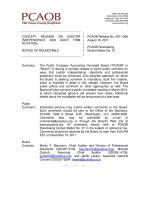
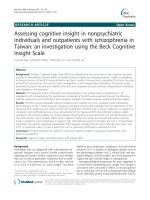
![thang nguyen ngoc - 2011 - corporate governance and its impact on the performance of firms in emerging countries - the evidence from vietnam [cg]](https://media.store123doc.com/images/document/2015_01/02/medium_rfd1420194809.jpg)
![arel et al - 2005 - audit firm rotation and audit quality [mafr]](https://media.store123doc.com/images/document/2015_01/06/medium_bqa1420548082.jpg)
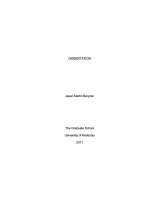
![cameran et al - 2012 - mandatory audit firm rotation and audit quality - evidence from the italian setting [mafr]](https://media.store123doc.com/images/document/2015_01/06/medium_jxw1420548106.jpg)
![gietzmann and sen - 2002 - improving auditor independence through selective mandatory rotation [mar]](https://media.store123doc.com/images/document/2015_01/06/medium_lkv1420548125.jpg)
